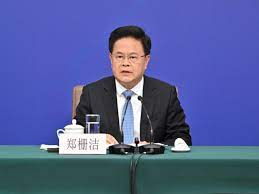
China's Economy Set to Surpass $19.5 Trillion in 2025, Says State Planner

 :
| Updated On: 09-Jul-2025 @ 2:50 pm
:
| Updated On: 09-Jul-2025 @ 2:50 pmSHARE
China’s economy is projected to surpass 140 trillion yuan (approximately $19.5 trillion) by the end of 2025, according to Zheng Shanjie, Chair of the National Development and Reform Commission (NDRC). This forecast comes as China nears the conclusion of its 14th Five-Year Plan (2021–2025) and begins shaping its next economic blueprint. Despite facing significant global and domestic challenges—including a prolonged trade war with the United States and ongoing deflationary pressures—China’s economic trajectory remains resilient.
Zheng acknowledged that the 14th Five-Year Plan period has been marked by unexpected difficulties, but overall achievements have surpassed initial expectations. Under the current plan, China has focused on several strategic pillars: promoting economic development, advancing technological innovation, pursuing green transformation, and enhancing people’s quality of life. These priorities have shaped policy directions since 2021 and will continue to influence planning for the next phase.
Significantly, China’s 14th Five-Year Plan did not include a fixed GDP growth target for the 2021–2025 period, a shift from previous approaches. However, the government has continued to set annual growth targets. For 2025, the target remains around 5%. From 2021 to 2024, China’s economy grew at an average annual rate of 5.4%, even amid disruptions caused by the COVID-19 pandemic. These figures suggest that China has been able to maintain relatively strong economic momentum under difficult global circumstances.
Zheng emphasized that China has now developed the largest and most comprehensive manufacturing sector in the world. Strengthening industrial capabilities and building robust supply chains have been key accomplishments under the current plan. These developments have not only bolstered China’s economic stability but also enhanced national confidence in the country’s ability to manage risks and respond to external shocks.
Foreign restrictions on Chinese technology access, particularly from Western nations, have prompted China to double down on self-reliance and domestic innovation. Zheng argued that such curbs have ultimately motivated the country to invest more in research, development, and indigenous technological capacity. This determination to achieve technological sovereignty is expected to play a major role in China's long-term strategic objectives.
While the 15th Five-Year Plan (covering 2026 to 2030) is still in the early stages of development, no specific policy details have been disclosed. Chinese leaders are in the process of gathering proposals that will define the country’s strategic focus for the next decade. However, one emerging theme is the growing call among government advisors to prioritize the role of the household sector in national economic growth.
These advisors argue that boosting domestic consumption is essential to counteract global trade uncertainties and internal deflationary risks. As China faces a shifting global economic landscape, strengthening household demand, improving income distribution, and enhancing social safety nets are seen as critical strategies for long-term, sustainable growth.
In conclusion, while China’s economy continues to grapple with external headwinds and structural transitions, it has demonstrated notable resilience and adaptability. The current Five-Year Plan has paved the way for industrial advancement and technological development, and as the 15th plan takes shape, greater emphasis may be placed on household consumption and internal economic balance to sustain China’s growth trajectory.